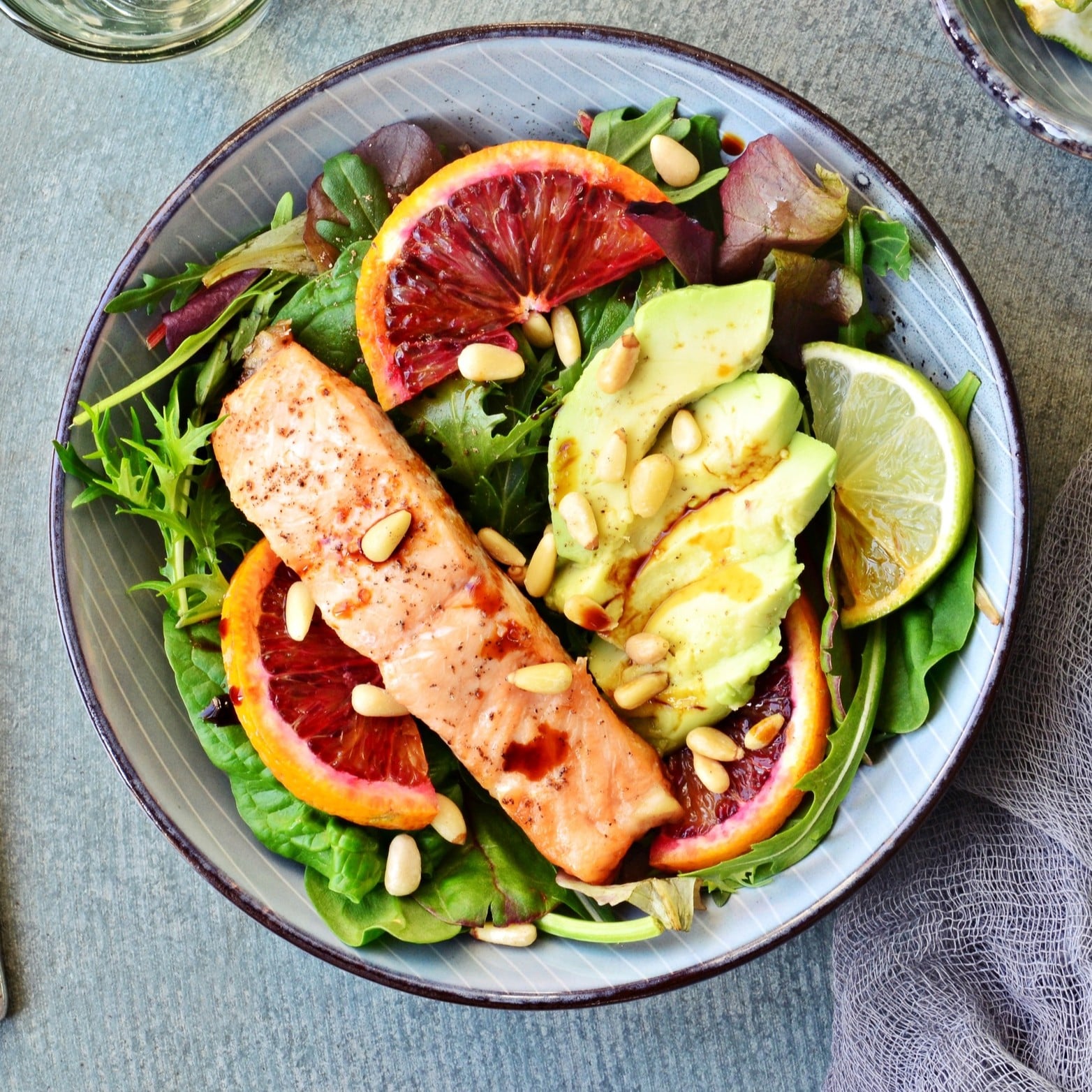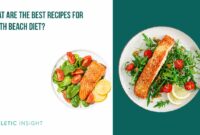South Beach Diet meals offer a delicious and effective approach to weight management. This diet, known for its phased approach and emphasis on healthy fats and lean proteins, distinguishes itself from other popular weight-loss plans. We’ll explore the core principles, delve into sample meal plans for each phase, and provide practical tips for meal preparation and adherence, ensuring a smooth transition into this lifestyle change. This guide aims to equip you with the knowledge and tools to successfully navigate the South Beach Diet and achieve your health goals.
Understanding the South Beach Diet’s phases is crucial. Phase 1 focuses on eliminating simple sugars and unhealthy fats to jumpstart weight loss. Phase 2 gradually reintroduces healthy carbohydrates while continuing to emphasize lean proteins and healthy fats. Phase 3, the maintenance phase, focuses on sustainable, long-term healthy eating habits. Throughout this journey, we will explore a variety of recipes, meal planning strategies, and address common challenges to make your South Beach experience both effective and enjoyable.
Understanding the South Beach Diet
The South Beach Diet is a popular weight-loss plan that emphasizes healthy eating habits rather than strict calorie restriction. Unlike many fad diets, it focuses on sustainable lifestyle changes that promote long-term weight management and improved overall health. The diet’s core principle is to prioritize nutrient-rich foods while minimizing processed carbohydrates and unhealthy fats.
Core Principles of the South Beach Diet
The South Beach Diet operates on the principle of controlling blood sugar levels through strategic carbohydrate selection. This approach aims to minimize insulin spikes, which can lead to fat storage. The diet prioritizes lean protein, healthy fats, and complex carbohydrates, leading to sustained energy levels and reduced cravings. It also encourages regular exercise and mindful eating habits for holistic weight management.
Phases of the South Beach Diet
The South Beach Diet is structured into three phases, each with specific dietary guidelines:
Phase 1 (Weeks 1-2): This is the most restrictive phase, focusing on eliminating simple sugars, processed foods, and unhealthy fats. The goal is to jumpstart weight loss and reduce inflammation. Permitted foods include lean protein, healthy fats (like avocados and olive oil), and non-starchy vegetables. Restricted foods include all sugary drinks, processed foods, white bread, pastries, and most fruits.
Phase 2 (Weeks 3-onwards): This phase gradually reintroduces healthy carbohydrates like whole grains and certain fruits, while continuing to restrict unhealthy carbs and processed foods. The focus is on maintaining weight loss and establishing sustainable eating habits. More fruits and whole grains are allowed than in Phase 1.
Phase 3 (Maintenance Phase): This phase is designed for long-term weight management. It allows for greater flexibility in food choices while still emphasizing healthy eating principles. Occasional indulgences are permitted in moderation, but the focus remains on maintaining a balanced and nutritious diet.
Permitted and Restricted Foods in Each Phase
The following table summarizes permitted and restricted foods in each phase:
| Phase | Permitted Foods | Restricted Foods |
|---|---|---|
| Phase 1 | Lean protein (fish, chicken, beans), healthy fats (avocado, olive oil, nuts), non-starchy vegetables (broccoli, spinach, peppers) | Sugary drinks, processed foods, white bread, pastries, most fruits, high-glycemic index foods |
| Phase 2 | Foods from Phase 1, plus whole grains (brown rice, quinoa), some fruits (berries, apples), limited amounts of legumes | Sugary drinks, processed foods, white bread, pastries, high-glycemic index foods |
| Phase 3 | Foods from Phases 1 and 2, with greater flexibility and occasional treats in moderation | Unhealthy fats, excessive processed foods, sugary drinks |
Comparison of the South Beach Diet to Other Popular Diets
The South Beach Diet differs from other popular diets in its approach to carbohydrates. While some diets completely restrict carbohydrates (like keto), the South Beach Diet focuses on choosing healthy carbohydrates and avoiding processed carbs.
| Diet | Carbohydrate Approach | Fat Approach | Protein Approach |
|---|---|---|---|
| South Beach | Prioritizes complex carbohydrates, restricts simple sugars and processed carbs | Emphasizes healthy fats (monounsaturated and polyunsaturated) | Lean protein sources encouraged |
| Mediterranean | Includes fruits, vegetables, and whole grains | Emphasizes olive oil and other healthy fats | Lean protein sources, primarily fish and poultry |
| Ketogenic | Severely restricts carbohydrates, promoting ketosis | High fat intake | Moderate protein intake |
South Beach Diet Meal Preparation and Planning
Successfully navigating the South Beach Diet hinges on effective meal preparation and planning. Proactive strategies simplify adherence, ensuring you consistently meet your dietary goals and avoid impulsive, unhealthy choices. This section outlines practical methods for streamlining your South Beach journey.
Effective Meal Prepping Strategies
Efficient meal prepping is crucial for South Beach Diet success. Preparing meals in advance minimizes the temptation to opt for less healthy options when time is short. Consider batch cooking larger portions of approved South Beach recipes on the weekend. Divide these portions into individual containers for easy grab-and-go meals throughout the week. This approach saves time and effort, ensuring you always have healthy, compliant meals readily available. Focus on versatile recipes that can be adapted for different meals throughout the week, such as roasted chicken breast that can be used in salads, wraps, or as a standalone protein source. Pre-cut vegetables and store them in airtight containers for quick additions to meals and snacks.
Grocery Shopping and Pantry Stocking
Smart grocery shopping is fundamental to South Beach Diet success. Before heading to the store, create a detailed shopping list based on your weekly meal plan. This prevents impulse purchases of non-compliant items. Prioritize whole, unprocessed foods such as lean proteins (chicken, fish, turkey), plenty of non-starchy vegetables (broccoli, spinach, peppers), and healthy fats (avocado, olive oil, nuts). Stock your pantry with South Beach-friendly staples: whole grains (quinoa, brown rice, oats), legumes (lentils, chickpeas), and a variety of spices and herbs to add flavor without extra calories or unhealthy additives. Avoid processed foods, sugary drinks, and refined carbohydrates.
Eating Out While Adhering to Diet Guidelines
Dining out while following the South Beach Diet requires careful planning and mindful choices. Before heading to a restaurant, review the menu online to identify compliant options. Choose grilled or baked dishes over fried options. Select lean protein sources, such as fish or chicken, and load up on vegetables. Be mindful of portion sizes and avoid creamy sauces or dressings high in saturated fat and sugar. When ordering salads, opt for vinaigrettes instead of creamy dressings. If unsure about an ingredient, don’t hesitate to ask your server for clarification. Many restaurants are now happy to accommodate dietary restrictions.
Weekly Meal Plan Template
A well-structured weekly meal plan is a cornerstone of successful South Beach Diet adherence. The following template provides a framework for planning your meals:
| Monday | Tuesday | Wednesday | Thursday |
|---|---|---|---|
| Grilled salmon with asparagus and quinoa | Chicken breast salad with mixed greens and olive oil vinaigrette | Lentil soup with whole-wheat bread | Turkey meatballs with zucchini noodles |
| Breakfast: Scrambled eggs with spinach | Breakfast: Greek yogurt with berries | Breakfast: Oatmeal with nuts and seeds | Breakfast: Smoothie with protein powder and fruits |
| Lunch: Leftover salmon and quinoa | Lunch: Leftover chicken salad | Lunch: Leftover lentil soup | Lunch: Leftover turkey meatballs |
| Dinner: Chicken stir-fry with brown rice | Dinner: Baked cod with roasted vegetables | Dinner: Shrimp scampi with zucchini noodles | Dinner: Chicken and vegetable skewers |
Recipes and Variations
The South Beach Diet emphasizes delicious, healthy eating, and doesn’t restrict you to bland, boring meals. This section provides five diverse recipes showcasing the flexibility and flavor potential within the diet’s guidelines. Remember to always adjust portion sizes to meet your individual caloric needs.
Italian: Lemon Herb Baked Salmon with Asparagus
This recipe offers a light and flavorful Italian-inspired dish, perfect for a weeknight dinner.
Ingredients: 1 salmon fillet (6-8 oz), 1 bunch asparagus, 1 lemon (juiced and zested), 2 cloves garlic (minced), 2 tbsp olive oil, 1 tbsp fresh herbs (Italian mix or parsley, oregano), salt and pepper to taste.
Instructions: Preheat oven to 400°F (200°C). Toss asparagus with 1 tbsp olive oil, salt, and pepper. Place on a baking sheet. In a small bowl, combine lemon juice, lemon zest, garlic, remaining olive oil, and herbs. Place salmon fillet on the baking sheet with asparagus. Pour lemon herb mixture over salmon. Bake for 12-15 minutes, or until salmon is cooked through and asparagus is tender.
Substitutions: Cod or halibut can replace salmon. Broccoli or green beans can substitute asparagus. Fresh dill or thyme can be used instead of Italian herbs.
Mexican: Shrimp Ceviche with Avocado
A refreshing and vibrant ceviche, perfect as a light lunch or appetizer.
Ingredients: 1 lb cooked shrimp (peeled and deveined), 1 avocado (diced), 1/2 cup red onion (finely chopped), 1/2 cup chopped cilantro, 1/4 cup lime juice, 1 jalapeño (seeded and minced, optional), salt and pepper to taste.
Instructions: In a bowl, combine shrimp, avocado, red onion, cilantro, lime juice, and jalapeño (if using). Season with salt and pepper. Gently toss to combine. Refrigerate for at least 30 minutes to allow flavors to meld. Serve with low-carb tortilla chips (optional).
Substitutions: White fish (like tilapia or snapper) can replace shrimp. Mango or grapefruit can be added for extra sweetness and flavor. Serrano pepper can substitute jalapeño.
Asian: Chicken and Vegetable Stir-fry
A quick and easy stir-fry packed with flavor and vegetables.
Ingredients: 1 lb boneless, skinless chicken breast (cubed), 1 cup broccoli florets, 1 cup sliced bell peppers (any color), 1/2 cup sliced mushrooms, 2 tbsp soy sauce (low sodium), 1 tbsp sesame oil, 1 clove garlic (minced), 1 tsp ginger (grated), green onions (chopped) for garnish.
Instructions: Heat sesame oil in a wok or large skillet over medium-high heat. Add chicken and cook until browned. Add garlic and ginger, cook for 1 minute. Add broccoli, bell peppers, and mushrooms. Stir-fry for 5-7 minutes, or until vegetables are tender-crisp. Stir in soy sauce. Garnish with green onions.
Substitutions: Tofu or shrimp can replace chicken. Cauliflower or snap peas can be added or substituted for other vegetables. Coconut aminos can replace soy sauce for a gluten-free option.
Mediterranean: Greek Salad with Grilled Chicken
A classic Mediterranean salad, made healthier with grilled chicken.
Ingredients: 4 oz grilled chicken breast (cubed), 1 cup chopped cucumber, 1/2 cup chopped tomatoes, 1/4 cup crumbled feta cheese, 1/4 cup Kalamata olives (halved), 2 tbsp olive oil, 1 tbsp red wine vinegar, oregano to taste, salt and pepper to taste.
Instructions: In a large bowl, combine chicken, cucumber, tomatoes, feta cheese, and olives. In a small bowl, whisk together olive oil, red wine vinegar, oregano, salt, and pepper. Pour dressing over salad and toss gently to combine.
Substitutions: Salmon or tuna can replace chicken. Goat cheese can substitute feta. Different types of olives can be used.
Southwestern: Turkey Chili
A hearty and satisfying chili perfect for a chilly evening.
Ingredients: 1 lb ground turkey, 1 onion (chopped), 1 green bell pepper (chopped), 1 (15-ounce) can diced tomatoes (undrained), 1 (15-ounce) can black beans (rinsed and drained), 1 (15-ounce) can kidney beans (rinsed and drained), 1 tbsp chili powder, 1 tsp cumin, 1/2 tsp oregano, salt and pepper to taste.
Instructions: Brown ground turkey in a large pot over medium heat. Drain off any excess fat. Add onion and bell pepper; cook until softened. Stir in diced tomatoes, black beans, kidney beans, chili powder, cumin, oregano, salt, and pepper. Bring to a simmer, reduce heat, and cook for at least 20 minutes, or until flavors have melded.
Substitutions: Ground chicken or beef can replace turkey. Different types of beans can be used. Chipotle peppers in adobo sauce can be added for extra heat.
Potential Challenges and Solutions
Embarking on the South Beach Diet, like any significant dietary change, presents certain hurdles. Understanding these potential challenges and developing proactive strategies to overcome them is crucial for long-term success and sustainable weight management. This section will outline common difficulties and provide practical solutions to help you navigate the journey smoothly.
Common Challenges Faced During the South Beach Diet
Many individuals encounter various obstacles while adhering to the South Beach Diet. These challenges often stem from lifestyle factors, social pressures, or the inherent difficulty of modifying ingrained eating habits. Successfully navigating these obstacles requires planning, self-awareness, and a commitment to long-term health goals.
Solutions for Overcoming Challenges
Addressing the challenges of the South Beach Diet requires a multi-faceted approach. This involves proactive planning, mindful eating strategies, and a strong support system. The following table summarizes common challenges and their corresponding solutions:
| Challenge | Solution |
|---|---|
| Cravings for sugary or processed foods | Gradually reduce sugar intake, focus on healthy alternatives like fruits and vegetables, and find satisfying substitutes such as sugar-free desserts or protein-rich snacks. Stay hydrated to help reduce cravings. |
| Difficulty finding suitable meals when eating out | Plan ahead by researching restaurant menus in advance, choose restaurants with healthier options, and select dishes that align with the diet’s principles (lean protein, vegetables, healthy fats). Don’t be afraid to request modifications to dishes. |
| Social situations involving unhealthy food | Prepare in advance by eating a healthy meal or snack before social gatherings. Make conscious choices at events, focusing on allowed foods, and don’t feel pressured to overindulge. Focus on socializing rather than the food. |
| Feeling deprived or restricted | Remember the long-term benefits of the diet. Focus on the positive aspects, such as increased energy levels and improved health. Allow for occasional treats within the diet’s guidelines to prevent feelings of deprivation. |
| Maintaining consistency and long-term adherence | Set realistic goals, track progress, and reward yourself for milestones achieved. Find a support group or partner to share your journey with. Remember that setbacks are normal; focus on getting back on track rather than giving up completely. |
The Importance of Consistency and Long-Term Adherence
Consistency is paramount to achieving lasting results on the South Beach Diet. While initial weight loss may be rapid, sustained weight management requires ongoing commitment to the diet’s principles. Long-term adherence not only helps maintain a healthy weight but also contributes to improved overall health and well-being, reducing the risk of chronic diseases such as heart disease and type 2 diabetes. A gradual approach to lifestyle changes, rather than a quick fix, is more likely to lead to lasting success. For example, individuals who consistently follow the diet for several months often experience significant improvements in blood pressure, cholesterol levels, and overall metabolic health.
Final Thoughts
Embarking on the South Beach Diet is a commitment to a healthier lifestyle, not just a temporary fix. By understanding the principles, planning your meals effectively, and addressing potential challenges proactively, you can maximize your chances of success. Remember, consistency and mindful eating are key to achieving sustainable weight loss and long-term well-being. This guide has provided a foundation; now, it’s time to embark on your culinary journey towards a healthier you.




